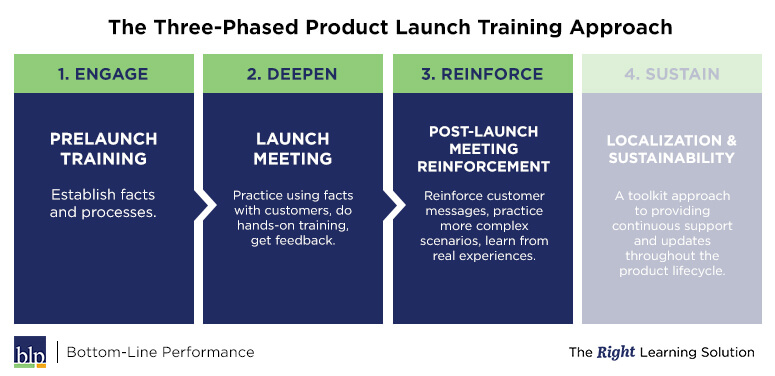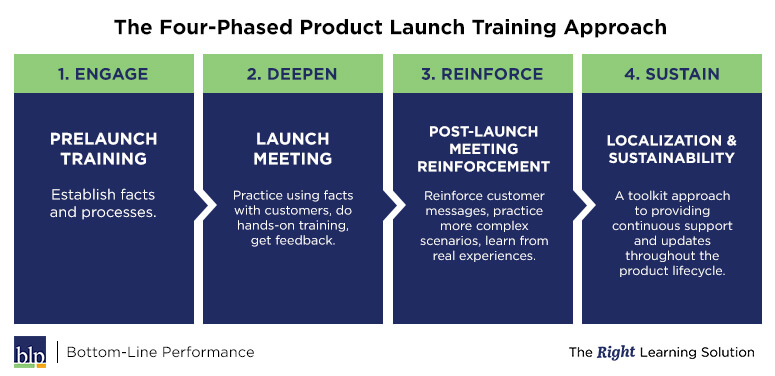For a long time, product launch training has been conducted with an event-based model. Reps show up for a launch meeting, listen as someone lectures through slide decks, spend a few days at a nice hotel, and head back to their territories.
In many cases, these launch events are not training-focused at all. They are planned and run by marketing folks who need reps to effectively position the new product but don’t have a realistic plan to make it happen.
Product managers and sales trainers in complex, competitive industries have long known that the event-based model is not enough. Home study modules are a mainstay in pharmaceutical and medical device launches. In some extreme scenarios, a sales rep might take half a dozen or more content-packed eLearning courses over a period of weeks or months before they attend a launch event.
Just like the launch events themselves, these pre-work modules often leave a lot to be desired. They are rich with content; so rich that they include content and topics that reps don’t really need to be successful. They are not learner-focused and reps usually treat them as something they must get through one time before moving on.
By the time the launch event comes around, they will have forgotten a large percentage of what they learned in these modules.
The Three-Phased Launch Approach
Product launch training vendors have long encouraged clients to adopt a three-phase product launch model. Basic facts and foundational knowledge are introduced in the pre-work. The launch meeting builds and deepens this knowledge and provides practice opportunities. Then post-launch tools are created to help reps commit what they’ve learned to long-term memory… or at least know where to look it up.
There is a great deal to be gained in moving from a one-and-done or two-phased launch to the three-phased approach. Even just focusing on the form and content of home study modules can greatly improve the learner experience and performance outcomes. But even if the pre-work and launch meeting were stellar, or if the post-launch reinforcement tools were brilliantly designed… what will happen when your carefully crafted training materials are in the hands of regional sales affiliates?
Many organizations can’t bring every single sales rep together for a launch meeting. In these cases, account managers and regional marketing leaders might attend a launch event and be expected to take the training to their home countries and train reps. Will they follow through? Are the tools easy for them to operationalize?
Three phases are a great start, but they aren’t enough. It turns out another phase is needed to make product launches successful over the long haul.
From Three Phases to Four
Experienced product managers will tell you that even three phases are not enough. It takes planning and following to ensure that:
- Reps actually use the reinforcement tools that were created.
- Launch materials can easily be fit into the workflow and schedules of regional affiliates.
- Launch materials are easy for managers to deliver to reps who did not attend the original launch meeting.
- Feedback mechanisms are in place so affiliates can get help from the business unit and fill knowledge gaps that emerge.
- Training materials can easily be updated as needed.
At BLP, we have introduced a fourth product launch phase with our clients. We call it Localization and Sustainability. The fourth phase focuses on making launch training as easy as possible for regional sales affiliates to use. It also makes product manager’s lives easier when the time comes to update training materials in the future.
How the Process Works
We recommend a toolkit approach to product launch training to make Localization and Sustainability easier to manage. Here’s how it works:
- Ongoing webinars are scheduled to check in with affiliates and answer questions.
- Launch training materials are designed to be modular and editable so they can be easily updated and expanded upon as product information changes.
- Training activities are structured so regional affiliates can mix and match, using just the pieces of training they need for their specific situation.
- Incentives and rewards are prepared to keep affiliates engaged for the long haul.
A product launch doesn’t truly end until a product has reached the end of its lifecycle. Product managers must continuously support their regional sales affiliates to ensure that messaging is aligned, value is accurately positioned, and marketplace changes are communicated.
A toolkit approach to product launch training makes this fourth phase a whole lot easier.






